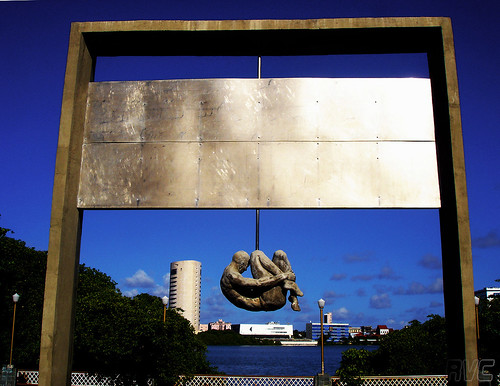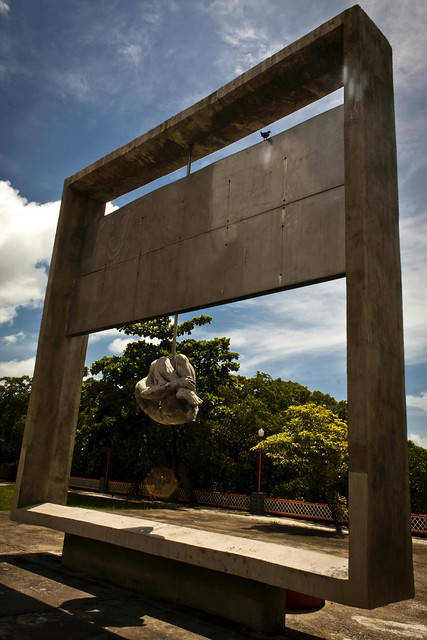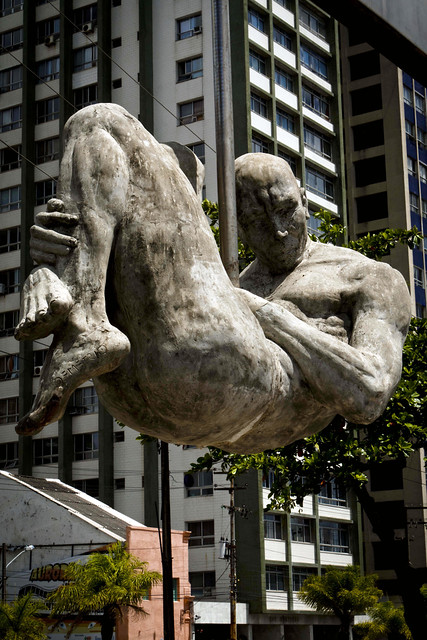
Monument Torture Never Again: Monumento Tortura Nunca Mais
The Torture Never Again Monument is a monument located in the plaza Father Henry, the Aurora Street , the city of Recife , Pernambuco , Brazil . It was the first monument built in the country to honor the dead and missing Brazilian politicians [1] . It was designed by architect piauiense Demetrio Albuquerque .
Its construction was due to a tender held by the city of Recife in 1988 , which provided not only the construction of a monument that emblemasse conditions of torture and disregard for human dignity to which the population was subject during the Brazilian military regime such as the revitalization of the entire site.
It was inaugurated on August 27 of 1993 and is since then regarded as one of the city's sights.

The monument "torture never" located in the square to the Father Henry Street intersection with Aurora Avenue Mario Melo is the first monument of the kind in the country built to honor the dead and missing political victims of the military dictatorship installed in Brazil in 1964.
Due to a competition held by the city of Recife and the movement never torture in February 1988, the first management Jarbas Vasconcelos, attended by more than 20 teams of artists and architects, with the winning design by architects Eric entered Perman, Alberico Paes Barreto Luiz Augusto Rangel and Demetrio Albuquerque. which is also responsible for the creation and execution of the sculpture of the monument. The announcement of the contest also provided for the redevelopment of the site.

It was built five years later by a lending agreement with the Brazilian Portland Cement Association, which wanted to deploy on the edge of the river Capibaribe an exhibition space on cement.
It was finally inaugurated on August 27, 1993 at 10 am with the presence of political leaders and relatives of dead and missing political

Monument described as a specific frame of 7.00 m x 7:00 hollow, having a stainless steel plate fixed on the upper half bearing a sculpture by a man hanging from a stainless steel rod, made in particular of approx. 1.80 x 1.60 x .80 m. In the fetal position with reference to the position of torture called "stick-to-parrot." holds with his left hand holds the rod. His face is turned toward the river Capibaribe as a protest, one who is ashamed of that.
This symbology was chosen as an emblem of the actual circumstances of torture during the military regime, more than that as a representation of the human condition of degradation, isolation, exclusion and abandonment that we have all been submitted and we are still all the times that human dignity is not respected in Brazil. (source: http://www.demetrioesculturas.com/2007/index.php?option=com_content&task=view&id=14&Itemid=48)
Pau-de-Arara
It is one of the oldest forms of torture used in Brazil - was in the days of slavery. With an iron bar between the crossed wrists and knees, the prisoner was naked, tied up and hung about 20 inches off the ground. In this position, which causes excruciating pain in the body, the prisoner suffered from shock, beatings and cigarette burns.
In Brazil, the torture of the poor has always been tolerated as a means of interrogation and punishment, or embarrass someone with violence or serious threat, causing him physical or mental suffering. Submit someone under his custody, power or authority to intense physical or mental suffering as a way of applying personal punishment or preventive measure. Torture is characterized with the purpose of obtaining information, statement or confession from the victim or third person. (source: http://alunos3detonando.blogspot.com/2008/11/tortura-nunca-mais.html)

The presence of African people in Brazil dates from the early moments of history. The first Africans arrived between 1550 and 1551 (XVI and XVII centuries), during the governorship of Sousa and concentrated especially in the Northeast territory.
Slaves were brought mainly to the northeast to the sugar industry, particularly for farms in Bahia and Pernambuco. In less number were sent to Pará, Maranhão and Rio de Janeiro. In the late seventeenth century, the discovery of gold in the province of Minas Gerais increases the volume of traffic that passes to lead the captives to the region of the mines. In the eighteenth century, the gold follows the demand for slaves in the sugar, coffee and sugar substitutes gold in the nineteenth century.

The routes of the African slave trade to the Americas and Brazil. S. ref.
The presence of African people in Brazil dates from the early moments of history. The first Africans arrived between 1550 and 1551 (XVI and XVII centuries), during the governorship of Sousa and concentrated especially in the Northeast territory.

The instruments of iron "punishments and penances" were used to punish slaves and submit: handcuffs, paddles, Gargalheiras (sort of a leash attached to the neck of the captive) etc..





No comments:
Post a Comment